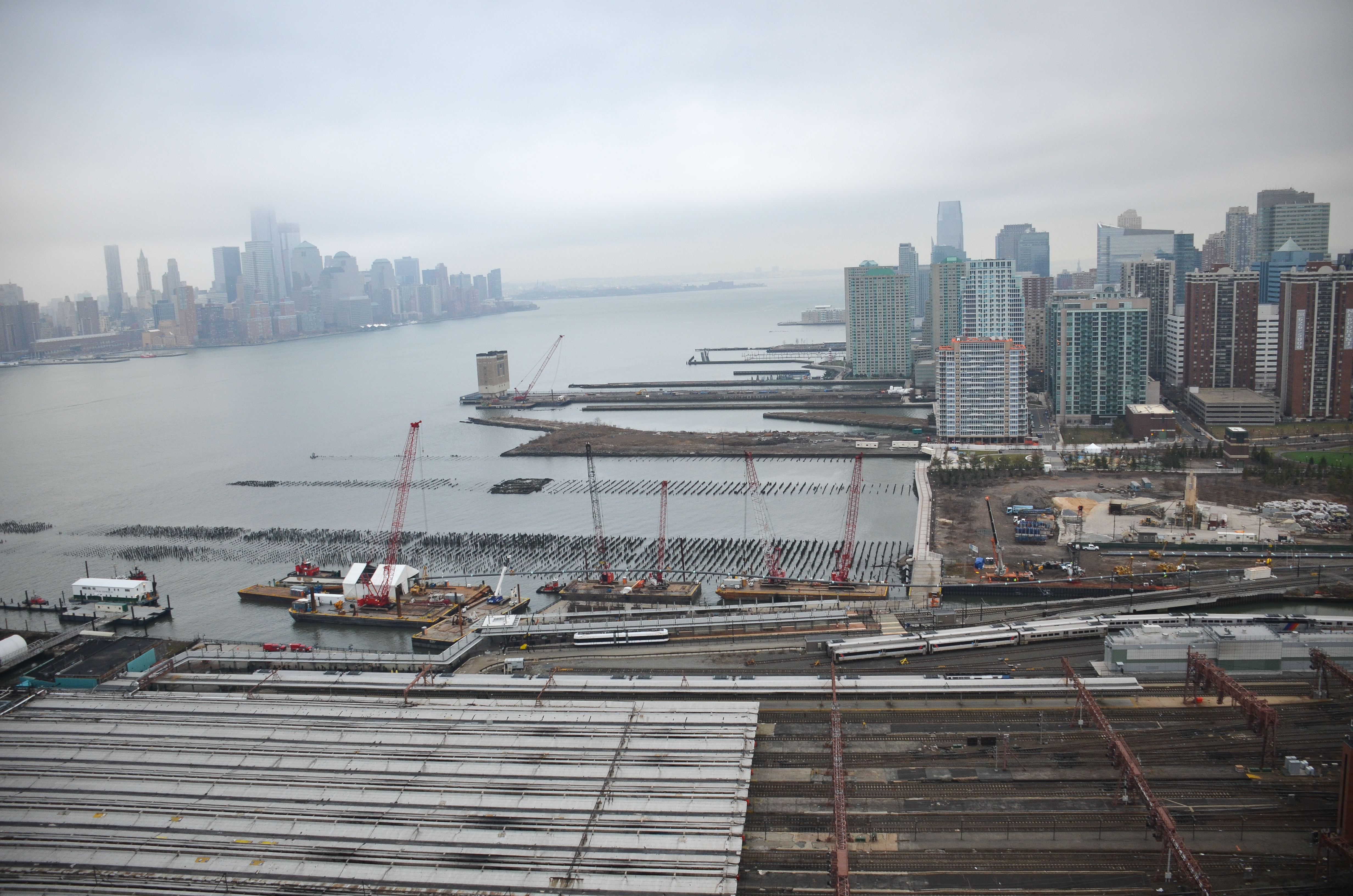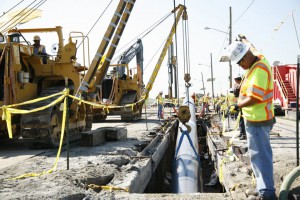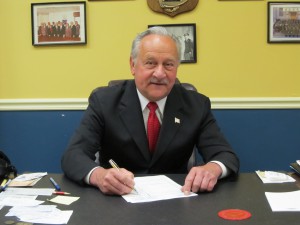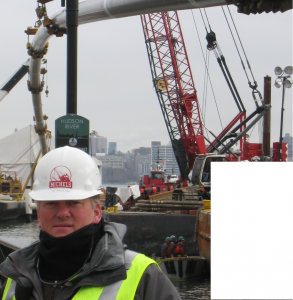July 2014, Vol. 241, No. 7
Features
Flexibility, Ingenuity And Patience Bring Gas To Gotham

Spectra Energy’s 20-mile expansion of the Texas Eastern and Algonquin Gas Transmission pipelines from Linden, NJ to Manhattan cost $60 million per mile, but the money is just the beginning.
Despite being nestled mere miles from the Marcellus shale play and offering one of the largest consumer gas markets in the world, in 2013, New York City was paying a 65% premium on natural gas prices versus Pennsylvania. Then, after five years of planning, nine directional drills, 20 miles of pipe, 37 environmental permits, a hundred-year storm, 350 stakeholder meetings, a 5,000-year-old cache of artifacts and a $1.2 billion investment, Spectra Energy’s New Jersey-New York expansion finished on time and on budget.
One more number illuminates the accomplishment: the project is predicted to save the New York City metro area a total of $700 million per year in energy costs, said Tina Faraca, vice president of Spectra Energy for engineering and construction. “We have been experiencing bottlenecks for many many years in the NJ-NY area and those bottlenecks have caused spikes in natural gas and electric prices,” Faraca said.
“The day before the pipe went into service, natural gas prices in Manhattan were nearly 40 cents cheaper than in Louisiana,” Faraca said. “That’s something that hasn’t occurred in many years.”
The relief came just in time to ameliorate a tough winter, which saw bidweek average gas prices jump to $20 MMBtu in New England in January. New York City escaped the brunt of the uncertainty. In February, the U.S. Energy Information Administration said, “Natural gas pipeline expansion into the New York City area may be providing a buffer against the frequency of price spikes this winter,” and suggested pipeline expansion into New England might help that region too.

The path to that end was not an easy one, though. Faraca, head of U.S. engineering and construction for the energy company and in charge of a planned $10 billion in U.S. pipeline investment before the end of the decade, said the difficulties of the project were mostly anticipated—but it was still one of the most challenging builds in the company’s history.
Planning, Outreach And Social License
The planning process took up the bulk of the five years the project spent on Spectra Energy’s books and included a lot of community outreach to determine what issues might crop up during construction.
“They were very organized about it, very proactive,” said Tim McGuire, vice president of Michels Drilling Crossings, the subcontractor for the directional drills on the project. “They started years in advance of the job, going around and getting to know all the local authorities and the property owners.”
But the long planning period paid off. Identifying where and around what social problems might arise meant the project team had time and resources to solve the issue or avoid it. And identifying potential problems early, before construction started, meant that the budget reflected those solutions.
Sometimes that meant altering the route, sometimes using HDD to go under instead of through a particular area. In one spot the pipeline route intersects heavily traveled Interstate 95. “Typically we would open-trench a highway like that,” Faraca said. “That would have caused extensive traffic congestion in that area, as you can imagine.” The line went underneath instead.
Some opposition groups objected to everything from natural gas itself to the Federal Energy Regulatory Commission, but more people worried about safety and the impact on the community in terms of construction, eminent domain issues and disruption. Spectra Energy responded with engineering fixes.
“Safety was a big concern,” Faraca said. “We built the safest pipeline in the industry by really going above and beyond many requirements from a safety perspective: how deep we buried the pipe, how thick the pipe is, the fact that we put a lot of the project into service through horizontal directional drills.” A daily aboveground patrol supplements typical round-the-clock SCADA monitoring, and high-visibility markers are embedded at road crossings to mark the location of the pipe for future workers.
To minimize community impact, Spectra Energy routed the entire 20 miles of pipeline through commercial and industrial property, avoiding residential properties altogether. Community acceptance was never universal, but support grew as the outreach efforts progressed.

“When you’re producing the facts and the information, it really helps turn the tide of opposition,” Faraca said. Doubling the amount of natural gas available in the area, providing a power source that was easier on the environment and lowering natural gas and energy costs were all powerful selling points. Spectra Energy estimated that replacing the existing fossil fuel energy sources with natural gas will forestall about 6 million tons of carbon dioxide emissions per year, the equivalent of taking a million cars off the road.
Once the benefits to the area became clearer, Faraca said, citizens “really just wanted the facts, to be listened to and their issues addressed. Some still didn’t want us there; that’s the nature of infrastructure.”
But there was positive feedback, too. The mayors of Linden and Bayonne, NJ both recognized Spectra Energy for its outreach efforts. Former New York City Mayor Michael Bloomberg was an early supporter of the project and emphasized its economic benefits to the city.
“It was a very pleasant experience from Linden’s perspective,” said Mayor Richard Gerbounka of Linden, which encompasses five miles of the pipeline right-of-way, including the beginning point of the expansion and sites where the line goes under the New Jersey Turnpike and the Arthur Kill waterway. “They were a very professional and responsible corporation that got the job done with a minimal amount of inconvenience to our city, although it was an enormous project and took a couple years.”

Specifically, the mayor said Spectra Energy always kept in touch with details of its activities, a facet of its community outreach that Michels’ McGuire also noticed.
“Once they had the permits to build the job, they had a proactive management staff in place to manage the day-to-day issues that come up,” McGuire said. “Then they would circle back and meet with people that they had established communications with on a regular basis just to make sure everybody was satisfied with the performance of the work and how it was going. They put in a tremendous effort to accomplish that.”

To gain its social license to build, Spectra Energy scheduled hundreds of meetings with local groups, including environmental activists, community groups and local office holders. A website to centralize support, yesgaspipeline.org, offered videos and information on crossings, detours, and road closures. Spectra Energy funded 50 scholarships for children from the area and provided both donations and labor to charity efforts, including hurricane relief projects.
Growing residential and commercial demand helped the project, too. The local distribution company, Consolidated Edison, signed on to take delivery of 170,000 dekatherms per day of natural gas. Con Edison’s support was important, Faraca said. “Just the fact that they were anchoring the project as a shipper was very important to us and was really what got us over the hurdle of expanding our system into Manhattan.” As plans progressed, natural gas producers Chesapeake Energy and Statoil came on board to join Con Edison as anchors to the project, bringing the overall capacity of the project up to 800,000 dekatherms per day.
Constructing Through A Spider’s Web
Faced with a densely populated area, organized opposition, busy subsurface right-of-ways, and a route through two bodies of water, the New Jersey Turnpike and a lot of bedrock, the company was prepared for the unexpected. “Our motto on our project teams is be prepared to be surprised,” Faraca said. “Often, we had contingency plans upon contingency plans.”
Surprises indeed came up. For instance, no one expected Superstorm Sandy. The cyclone came ashore in New Jersey on Oct. 29, 2012, with 90-mile-an-hour winds and over 11 inches of rain.
“The East Coast got hit pretty hard with Hurricane Sandy. The city of Linden got a tidal surge from the Arthur Kill, which is a waterway between Linden and Staten Island, and it created major flooding in the Tremley Point section of our community,” said Gerbounka.
Luckily, there was some warning. “It took our contractors two to three days to prepare for the storm–to close ditches, secure equipment and move their people out,” Faraca said.
“Nobody expected it to be that bad,” said McGuire. “Those were historical water levels.”
In Linden, heavy construction materials floated away, some into flooded homes. The company compensated homeowners as soon as floodwaters receded, Gerbounka said.
A directional drill across the Hudson River into Manhattan was a major point of concern—drilling rigs were positioned on a marine platform in the middle of the river, ready to join up a 5,400-foot river crossing bore with a 4,800-foot bore into 18th Street in Manhattan, where tight turn radiuses and bedrock added to the difficulty.

Crews unloaded equipment from the marine platform and brought it into safe harbor, responding to the severity of the storm by taking it farther inland than the initial tropical storm plan had suggested. That drill lost a week and a half; overall, it was two weeks before construction could resume. The whole region experienced heavy damage.
“We survived, but it was an experience I wouldn’t wish on my worst enemy,” Gerbounka said.
Spectra Energy donated money, labor and experience to the relief efforts. “We provided relief services and materials,” said Marylee Hanley, who led the community outreach efforts for Spectra Energy. The company wanted to demonstrate commitment to the community on an individual level.
“Giving back to the communities where we live and work is one of Spectra Energy’s core values, and we are glad to pitch in and help,” said Hanley. “We are very proud of how we helped the region deal with the effects of Superstorm Sandy. After the hurricane made landfall, our staff in the region donated goods to local nonprofits, project management offered up our equipment and expertise for cleanup, and Spectra Energy employees throughout the country took advantage of our corporate matching program to help give the Red Cross the resources it needs to aid families who lost so much during the storm.”

Meanwhile, work went on.
The drill under the Hudson River was one of nine completed for the project, all overseen by Michels.
“Each one of the nine crossings had its own unique challenges,” said McGuire. “Every state-of-the-art methodology that’s ever been used was applied on this project.”
The project faced strong magnetic interference and tight tolerances, requiring the use of guidance systems that had not been deployed on a large scale before in order to complete precise drills in confined spaces without equipment malfunctions.
“You had to barely miss these easement corners within five or ten feet, and you’re 150 feet underground in solid rock, so you have be very careful how you track the steering assembly for the HDD pilot holes,” McGuire said.
The 8,100-foot, 30-inch Kill Van Kull drill currently holds the record for the longest pipeline bore at that diameter in North America. Three 42-inch bores ranged in length from 3,000-4,400 feet, and another five 30-inch bores of 1,700 feet and more were needed as well.
Crews also had congested underground spaces to navigate. “That area has been populated for a long time and the infrastructure in the ground makes you look at the right-of-way three-dimensionally,” said Tarry Hutton, director of Pipeline Operations at Henkels & McCoy, Inc., which handled pipeline fabrication for the project’s six 30-inch directional drills, speaking at a conference.
Planning was no less rigorous for crossings than any other aspect of the job. The operator brought in its contractor to consult on the feasibility of such challenging connections well before construction began.
“Spectra Energy went through and identified the best routes,” McGuire explained. “Once they narrowed down some of the areas they needed to cross, if there was a need for a trenchless crossing we would get involved and evaluate the constructability of the workspace, the geotechnical conditions.
“Sometimes the geotechnical conditions were prohibitive to HDD construction. So we’d find a better way to drill and maybe move the location a little bit and come up with some alternative methods to initiate the HDDs.”
Despite the long lead time on the project, once the dirt began flying the schedule was tight. At one point, Michels had 10 big-rig units working on the project at once, with six bores happening simultaneously. All HDD work was completed within about a year.
Standard trench depth on the project was a minimum of three feet of ground cover and eight-foot trenches, but under streets the cover deepened to five feet with 10-foot trenches. Crews often encountered abandoned utilities or infrastructure not known from drawings.
And then, under the streets of Staten Island, the project team found buried treasure: an archaeological site with some artifacts estimated to be 5,000 years old.
More than 24,000 artifacts were uncovered, including stone tools, cooking utensils and ceramics, hinting at ways of life on the island for Native American and colonial Dutch inhabitants.
“That discovery added a really new and noteworthy dimension to the archaeological record of New York City, which, due to the vast urbanization, really had relatively under-documented any Native American history,” Faraca said. “Since Staten Island was developed long before advanced archaeological and anthropological studies became popular, the information about the early cultures of the area is actually poorly recorded and not well understood.”
Spectra Energy developed an outreach program on the finding to tell the story of the city’s past. Schools, other educational institutions, and the general public were invited to see the artifacts on display in a Staten Island museum, while video and other materials about the find were distributed throughout the community.
Not everything the team dug up was pleasant, of course. Industrial contamination on sites in New Jersey and a high water table increased the difficulty of dealing with even simple trenching. Water brought out had to be processed and treated before being discharged. “We had to bring in mobile trailer-mounted water-treatment systems that were operated around the clock to keep the ditch water-free and not impede the work we were doing,” Faraca said.
Contaminated earth, too, had to be cared for. “Every single spoonful of dirt that came out of the ground had to be hauled off, manifested, and taken to designated landfills,” said Hutton.
“We’ll look back upon here years from now,” McGuire said, and ask ‘“How in the heck did they do that?’ and ‘Could you do it again?’ and I don’t know anybody could say for sure that they could do it again.”
More Expansion To Come
Spectra Energy, however, plans to continue building out its resources in the populous Northeast. Its Algonquin Incremental Market (AIM) project, an expansion of the Algonquin Gas Transmission system to bring supplies from Appalachian production further into the Northeast is under review with FERC, with a 2016 target in-service date. Maps show a proposed route through northern New Jersey and New York, terminating in Boston.
The Atlantic Bridge Project proposes to connect natural gas supplies with markets in the New England states and Canadian Maritime provinces through an expansion of Spectra Energy’s Algonquin and Maritimes & Northeast Pipeline systems. That project is a direct response to the attempt to bring more gas into the New England area punished by spiking gas prices last winter, and has already completed a “favorable” open season.
Faraca said the company is paying close attention to the proposals put forth by the New England States Committee on Electricity suggesting ways to pass pipeline construction costs on to ratepayers, and to the Public Utilities Commission trying to incentivize building more gas infrastructure into Maine.
“We’re certainly encouraged that they recognize the need for additional natural gas supply and infrastructure in the region and that they‘re working collectively to try and make that happen,” she said. “That’s very encouraging to us.”





Comments